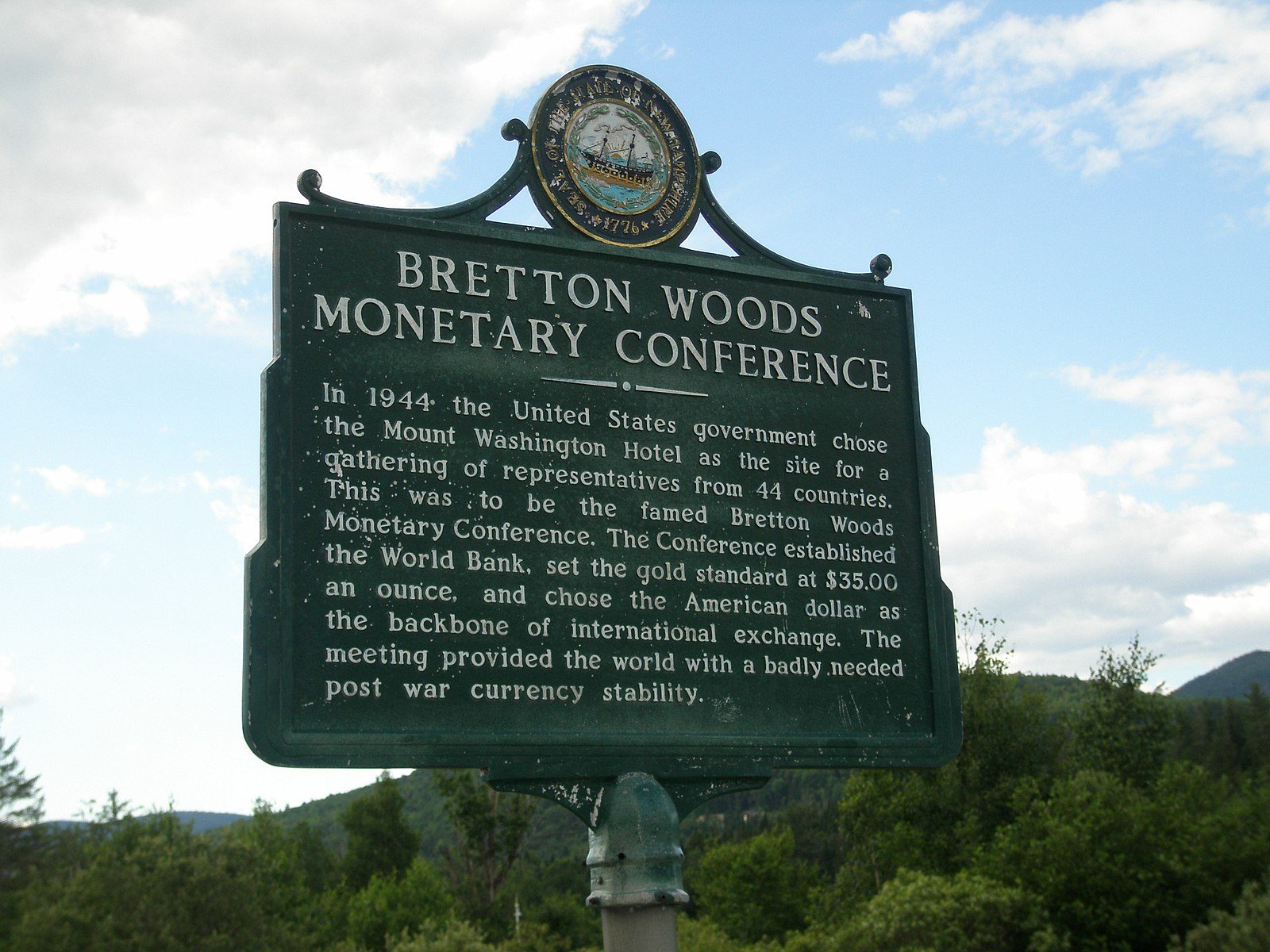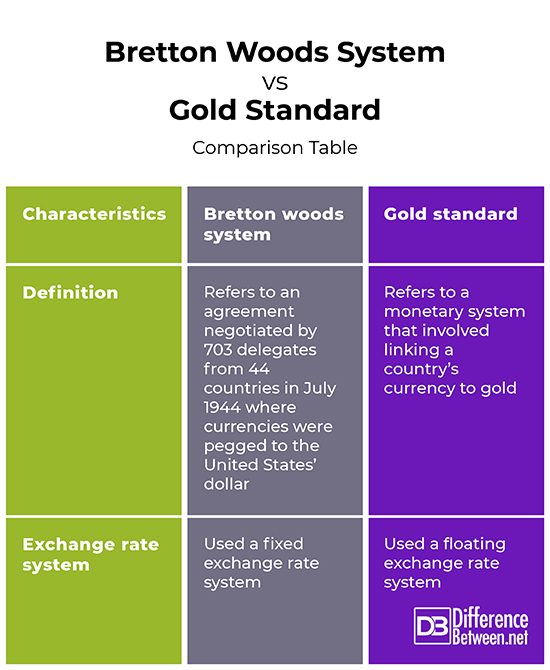Difference Between Bretton Woods System and Gold standard
Various forms of currencies have been used as accepted forms of payment of goods and services globally such as fiat money, commodity money, commercial bank money and fiduciary money. Despite its regulation, money remains a sensitive item since it can cause an economic imbalance if unregulated. The regulation of money is an interesting journey globally. In a bid to regulate money, various agreements seeking to regulate money have been passed worldwide. In this article, we will look at the differences between Bretton wood systems and Gold standard.

What is Bretton Wood Systems?
This was an agreement negotiated by 703 delegates from 44 countries in July 1944. It was carried out in Bretton Woods, New Hampshire at the United Nations Monetary and Financial Conference. This is why the agreement was called Bretton Woods Agreement.
Under this system, gold was used as the basis for the United States’ dollar. Other currencies were also linked to the U.S dollar value. This system, however, came to an end in the early 1970s when an announcement was made by President Richard M. Nixon stating that the U.S would not exchange gold for U.S currency.
The delegated met to create an efficient foreign exchange system, promote international economic growth and prevent competitive currency devaluations. The agreement created the World Bank and the International Monetary Fund (IMF). Even with the dissolution of the Bretton Woods system, the World Bank and IMF remained vital pillars for international currencies exchanges.
Once the agreement was implemented, its provisions stated for the US dollar to be secured to the value of gold while the other currencies were attached to the value of the U.S dollar. At the time, the exchange rate for gold was $35 for each ounce.
Benefits of the Brett Woods agreement
- It brought together the 44 countries involved
- It led to the creation of the World Bank and the IMF
- The currency pegs provided stability in the exchange rates for the trade of services and goods
- It reduced the volatility of the international currency exchange rate
- The stability in foreign exchange led to the successful provision of grants and loans by the World Bank
Despite its collapse in 1973, it remains vital in the financial history of the world. The two institutions created continue to serve global authorities.

What is Gold Standard?
This is a monetary system that involved linking a country’s currency to gold. The system was governed by a country’s agreement to convert currencies based on a fixed amount of gold. The fixed price was then used as a measure of the paper money’s value. Domestic currencies were convertible to gold at a fixed rate. Also, there were zero restrictions on the export or import of gold.
The formalization and development of the gold standard began in 1696 and 1812.
The gold standard is no longer in use by any government. Britain ceased the use of the currency in 1931 followed by the U.S in 1933. The system was replaced by fiat money, a mandate by the government to use a given type of currency.
Advantaged of the gold standard include:
- Due to the use of the physical quantity of gold, the issuance of the form of currency was controlled
- It made it easier for the society to adhere to given rules hence promoting a stable monetary environment
Similarities between Bretton woods system and Gold standard
- Both were supported by global powers worldwide
- Both aimed for a stable exchange rate system and the global promotion of trade
Differences between Bretton woods system and Gold standard
Definition
Bretton woods system refers to an agreement negotiated by 703 delegates from 44 countries in July 1944 where currencies were pegged to the United States’ dollar. On the other hand, the gold standard refers to a monetary system that involved linking a country’s currency to gold.
Exchange rate system
While the Bretton woods systems used a fixed exchange rate system, the gold standard used a floating exchange rate system.
Bretton woods system vs. Gold standard: Comparison Table

Summary of Bretton woods system vs. Gold standard
Bretton woods system refers to an agreement negotiated by 703 delegates from 44 countries in July 1944 where currencies were pegged to the United States’ dollar. On the other hand, the gold standard refers to a monetary system that involved linking a country’s currency to gold. While the Bretton woods system used a fixed exchange rate system, the gold standard used a floating exchange rate system. Despite the differences, both aimed for a stable exchange rate system and the global promotion of trade.
- Difference Between Profit Center and Investment Center - July 2, 2022
- Difference Between Anti-Trust and Anti-Competition - June 6, 2022
- Difference Between Stocktaking and Stock Control - June 6, 2022
Search DifferenceBetween.net :
1 Comment
Leave a Response
References :
[0]Image credit: https://en.wikipedia.org/wiki/File:Bretton_Woods_Monetary_Conference_historical_marker_(2007).jpg
[1]Image credit: https://live.staticflickr.com/65535/49655594231_8585f2b954_b.jpg
[2]Shapiro I & Lamoreaux N. The Bretton Woods Agreements. Yale University Press, 2019. https://books.google.co.ke/books?id=qI-fDwAAQBAJ&printsec=frontcover&dq=Difference+between+Bretton+woods+system+and+gold+standard&hl=en&sa=X&ved=2ahUKEwiblbby1dnuAhW2AWMBHSLUBEEQ6AEwAHoECAUQAg#v=onepage&q=Difference%20between%20Bretton%20woods%20system%20and%20gold%20standard&f=false
[3]Kathrin C. Hägele. The Bretton Woods System of Fixed Exchange Rates - Theoretical Background and Its Development. GRIN Verlag, 2010. https://books.google.co.ke/books?id=sYJ2klaSXQgC&printsec=frontcover&dq=Difference+between+Bretton+woods+system+and+gold+standard&hl=en&sa=X&ved=2ahUKEwiblbby1dnuAhW2AWMBHSLUBEEQ6AEwA3oECAYQAg#v=onepage&q=Difference%20between%20Bretton%20woods%20system%20and%20gold%20standard&f=false
[4]Anna J. Schwartz. Money in Historical Perspective. University of Chicago Press, 1987. https://books.google.co.ke/books?id=Oco-yeAJhaEC&printsec=frontcover&dq=Difference+between+Bretton+woods+system+and+gold+standard&hl=en&sa=X&ved=2ahUKEwiblbby1dnuAhW2AWMBHSLUBEEQ6AEwAXoECAIQAg#v=onepage&q=Difference%20between%20Bretton%20woods%20system%20and%20gold%20standard&f=false

Bwana ametoa bwana ametwaa jina la bwana lihimidiwe